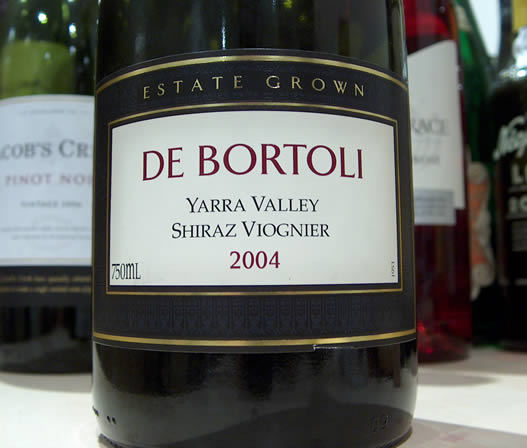|
Extended tasting note
De Bortoli Yarra Valley Shiraz Viognier 2004

The idea behind the 'extended tasting notes' is that I describe my
perceptions of a particular wine in context, adding into the mix the
drinking occasion itself, together with any pertinent background
information. The idea is to produce a tasting note with a bit more
oomph, that's more likely to be useful than a simple list of
descriptors. Here's the latest, on a rather interesting Australian
red.
The context here? It's 22:50 on a Sunday evening. I've been
drinking the same wine all evening, trying to get a good feel for it;
digging below the surface; going back to check whether my initial
perception tallied with later visits to the same wine. Drinking wine
over the course of a couple of hours has two effects: first, it's
likely that with exposure to air that the wine changes – this is the
principle behind decanting. Second, the exposure to wine alters the
perception of the taster a little (or a lot – depending on how much
is consumed).
It's the end of a full day. We lunched with some friends at The
Crown in St Margarets, on the side of Marble Hill Park. They also have
a dog, and we brought ours along because this is one of those rare
pubs that welcomes both children and animals. We followed this with a
walk through Marble Hill Park, where the dogs happily tired each other
out.
Tea tonight (which is what those of us with northern roots call
dinner, sometimes at least) was rib-eye steak with chestnut mushrooms
and potato dauphenoise. So I decided to match this with a robust,
structured Australian cool-climate Shiraz – De Bortoli's Shiraz
Viognier 2004 Yarra Valley. I'm somewhat of a sceptic about trying to
make an exact science out of food and wine matching, but I'm coming
round to the view that wine is really best drunk at table, with food.
By all means extend the mealtime and hang around the dining table for
longer, but keep the wine for the table. Good wine isn't meant to be
drunk on its own, although of course it can be.
Now to the wine. I bring some context to this drinking experience,
and to a degree I expect this to shape my perception. I've been to De
Bortoli in the Yarra Valley, and I've met with the winemaker Steve
Webber. I have a feeling (and sympathy for) what he is trying to
achieve, and there's a chance that this will influence my report here.
It's only fair that you should know this, even though I will try my
best to be unbiased and accurate in my description. But this context
also adds understanding. I reckon that knowledge about the wine and
where it has come from can enhance the pleasure derived by its
consumption, and that while tasting blind is useful and necessary,
it's not the best way to enjoy fine wine.
More context. Let's begin with the weather. Many people think that
the climate can influence tasting perceptions, with some days much
better for tasting than others. The last couple of weeks have been
pretty damp here in the UK: we've had rain most days, with some
scattered sunshine. The unsettled conditions may well affect the way
that wines show: many people whose opinions I respect report wines
tasting better or worse depending on environmental variables, most
commonly air pressure, but perhaps also the natural rhythms of the
biodynamic calendar, of which I'm unsure, slightly sceptical, but
always open-minded.
So, to this wine. It's sealed with a natural cork of good quality,
and has an alcohol level of 14%. It is made with the addition of a
small amount of Viognier, and some whole bunches are used (which
implies that the stems have been included).
In the glass it is dark coloured. I'm a little surprised by the
nose, but pleasantly so, because this has a vivid spicy, peppery
freshness as well as the expected ripe red and black fruits. There's a
bit of black olive as well, which makes me think of Northern Rhône
Syrah. This is rare for Australia. The palate is similarly striking,
with a spicy firmness, high acidity and tight, focused structure.
There's a fair whack of intense, ripe fruit, but at the same time it's
quite savoury and flirts with greenness: I think this is what gives it
the olive-like character. This would be a fascinating wine to taste
blind: it's not as sweetly fruited as most Australian wines –
indeed, its verging on the stern. I reckon it's a good candidate for
extended ageing; right now it's a brilliant, peppery, vivid
food-friendly wine. (£13.99 Tesco, Oddbins)
Other
ETNs:
Grünhaus;
Roc des Anges; Gaillard;
Veratina; Arturo;
Wynns; Drystone;
Foundry and Columella; Meruge;
Foillard Morgon; Clonakilla;
Latour 1934; Thevenet
Bongran
tasted
06/07
Back to top
|

